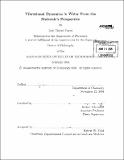Vibrational dynamics in water from the molecule's perspective
Author(s)
Eaves, Joel David, 1976-
DownloadFull printable version (9.447Mb)
Other Contributors
Massachusetts Institute of Technology. Dept. of Chemistry.
Advisor
Andrei Tokmakoff.
Terms of use
Metadata
Show full item recordAbstract
Liquid water is a fascinating substance, ubiquitous in chemistry, physics, and biology. Its remarkable physical and chemical properties stem from the intricate network of hydrogen bonds that connect molecular participants. The structures and energetics of the network can explain the physical properties of the substance on macroscopic length scales, but the events that initiate many chemical reactions in water occur on the time scales of [similar to] 0.1 - 1 picosecond. The experimental challenges of measuring specific molecular motions on this time scale are formidable. The absorption frequency of the OH stretch of HOD in liquid D₂0 is sensitive to the hydrogen bonding and molecular environment of the liquid. Ultrafast IR experiments endeavor to measure fluctuations in the hydrogen bond network by measuring spectral fluctuations on femtosecond time scales, but the data do not easily lend themselves to a direct microscopic interpretation. Computer simulations of empirical models, however, offer explicit microscopic detail but must be adapted to include a quantum mechanical vibration. I have developed methods in computer simulation to relate spectral fluctuations of the OH stretch in liquid D₂0 to explicit microscopic information. The experiments also inform the simulation by providing important quantitative data about the fidelity and accuracy of a chosen molecular model, and help build a qualitative picture of hydrogen bonding in water. Our atomistic model reveals that ultrafast experiments of HOD in liquid D₂0 measure transient fluctuations of the liquid's electric field. On the fastest time scales, localized fluctuations drive dephasing, while on longer time scales larger scale molecular reorganization destroys vibrational coherence. (cont.) Because electric fields drive vibrational dephasing, the frequency of the OH stretch is particularly sensitive to the microscopic details of the molecular potential. With collaborators, I have examined the accuracy of emerging fluctuating charge models for water and the role that molecular polarizability plays in the vibrational spectroscopy. In liquid water at ambient conditions, roughly 90 % of the hydrogen bonds are intact. I have examined the fates and the fundamental chemical nature of the remaining 10 % of the "broken" hydrogen bonds. We consider two reaction mechanisms that describe how hydrogen bonds change partners. In the first scenario, broken hydrogen bonds exist in stable chemical equilibrium with intact hydrogen bonds. In an alternate scenario, the broken hydrogen bond is not a meta-stable chemical state but instead a species that molecules visit during natural equilibrium fluctuations or when trading hydrogen bonding partners. I show how the methods of condensed phase reaction dynamics can be directly applied to vibrational spectroscopy of reactive systems and how experimental 2D IR spectra can distinguish between the two mechanistic scenarios. Our data support the notion that broken hydrogen bonds are an intrinsically unstable species in water and return to form hydrogen bonds on the time scale of intermolecular motions.
Description
Thesis (Ph. D.)--Massachusetts Institute of Technology, Dept. of Chemistry, 2005. Vita. Includes bibliographical references.
Date issued
2005Department
Massachusetts Institute of Technology. Department of ChemistryPublisher
Massachusetts Institute of Technology
Keywords
Chemistry.